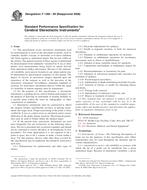Potřebujeme váš souhlas k využití jednotlivých dat, aby se vám mimo jiné mohly ukazovat informace týkající se vašich zájmů. Souhlas udělíte kliknutím na tlačítko „OK“.
ASTM F1266-89(2008)
Standard Performance Specification for Cerebral Stereotactic Instruments (Withdrawn 2017)
Automaticky přeložený název:
Standard Specification výkon pro mozkových stereotaktickou nástroje
NORMA vydána dne 1.2.2008
Informace o normě:
Označení normy: ASTM F1266-89(2008)
Poznámka: NEPLATNÁ
Datum vydání normy: 1.2.2008
Kód zboží: NS-49690
Počet stran: 6
Přibližná hmotnost: 18 g (0.04 liber)
Země: Americká technická norma
Kategorie: Technické normy ASTM
Kategorie - podobné normy:
Anotace textu normy ASTM F1266-89(2008) :
Keywords:
Anesthesia equipment--specifications, Application, Cerebral stereotactic instruments, Mechanical performance considerations, Neurosurgical medical devices/applications--specifications, Performance--surgical materials/applications (specifications), Probe, Radiation exposure--medical applications, Radiological examination, Safety precautions--medical materials/applications, Stereotactic instruments/systems, Surgical instruments--specifications
Doplňující informace
| Significance and Use | ||||
|
The purpose of a stereotactic apparatus is to guide the advance of an electrode or other probe accurately and in a controlled fashion to a given point in space, relative to the apparatus, to the stereotactic target. Thus, when the apparatus is attached to the skull, the electrode or probe can be advanced to a given geographical point within the cranial cavity, near the base of the skull or in the spinal canal. As generally employed, the ventricles or cavities within the brain or other neurosurgical landmarks are identified roentgenographically by other means and, by consulting an atlas or other table, the mean distance and direction between the visualized landmark and a given anatomical target are measured. The electrode or probe is then inserted to the stereotactic target, that is, the point in space which is calculated from the distance and direction between the visualized landmark and the desired target in relation to the coordinate system of the stereotactic apparatus. It is recognized that there is considerable anatomical variability in the size and shape of the central nervous system so that the target point that is identified from the atlas or table is only approximate. Usually, where possible, physiological verification may also be obtained. One must distinguish between the anatomical accuracy, which is inexact because of the variability of brains, and the mechanical accuracy, which is a function of the precision of the stereotactic instrument. The requirements set forth herein are concerned only with the mechanical accuracy of stereotactic instruments. It is also recognized that once minimum standards for mechanical accuracy have been obtained, increased mechanical precision will not necessarily lead to increased anatomical precision. |
||||
| 1. Scope | ||||
|
1.1 This specification covers stereotactic instruments used by neurosurgeons to assist in the placement of probes, such as cannulae, needles, forceps, or electrodes or to direct radiation into brain regions or anatomical targets that are not visible on the surface. The general location of these regions is determined by measurements from landmarks visualized by X ray or other means, such measurements being based on atlases derived from anatomical studies and autopsy. Because of the anatomical variability, more precise location in any single patient may be determined by physiological responses in that patient. The degree of success in stereotactic surgery depends upon the experience of the surgeon as well as the precision of the stereotactic instrument. Nevertheless, minimum standards of accuracy for stereotactic instruments that are within the range of variability of human anatomy must be maintained. 1.2 For the purpose of this specification, a stereotactic instrument is a guiding device used in human neurosurgery for the purpose of directing an instrument or treating modality to a specific point within the brain by radiographic or other visualization of landmarks. 1.3 Stereotactic instruments must be constructed to afford the surgeon reliably reproducible accuracy in placing instruments into target areas. Proper positioning of the probe is often verified by X rays to control errors in calculation and to correct deflection of the probe during insertion. Physiological parameters may be used to further define the optimal target. 1.4 At the present time, stereotactic instruments are used most frequently, but not exclusively in the following operations. The list is presented only to present examples and should not be construed to restrict advances or developments of new procedures. For some applications it is not required to hit a point in space, but to hit a volume or make a lesion within a mass. For that purpose, devices other than those covered by this specification may be employed, but should be restricted to such uses: 1.4.1 Thalamotomy for parkinsonism and other types of tremor, 1.4.2 Electrode implantation for epilepsy, 1.4.3 Needle or magnetic insertion, or both, for aneurysm thrombosis, 1.4.4 Thalamic or subthalamic operations for dystonia, 1.4.5 Thalamic or subthalamic operations for involuntary movements such as chorea or hemiballismus, 1.4.6 Ablation of deep cerebellar nuclei for spasticity, 1.4.7 Cingulotomy and thalamic or subthalamic surgery for pain, 1.4.8 Mesencephalotomy or tractotomy for pain, 1.4.9 Ablations of subcortical temporal lobe structures for treatment of epilepsy, 1.4.10 Psychosurgical procedures, 1.4.11 Implantation of depth stimulating electrodes for pain, 1.4.12 Insertion of forceps or needle for obtaining biopsy specimens, 1.4.13 Foreign body removal, 1.4.14 Implantation of radioactive material, and 1.4.15 Biopsy or treatment of tumors. 1.5 This standard does not purport to address all of the safety concerns, if any, associated with its use. It is the responsibility of the user of this standard to establish appropriate safety and health practices and determine the applicability of regulatory limitations prior to use. |
||||
| 2. Referenced Documents | ||||
|
Odebírejte informace o nově vydaných normách ZDARMA:
Chcete pravidelně odebírat informace o nově vycházejících normách z celého světa a to zcela zdarma?
Přihlašte se k odběru. Vše je velice jednoduché a absolutně ZDARMA.
Na výběr máte vydavatele z celého světa.




 Cookies
Cookies
